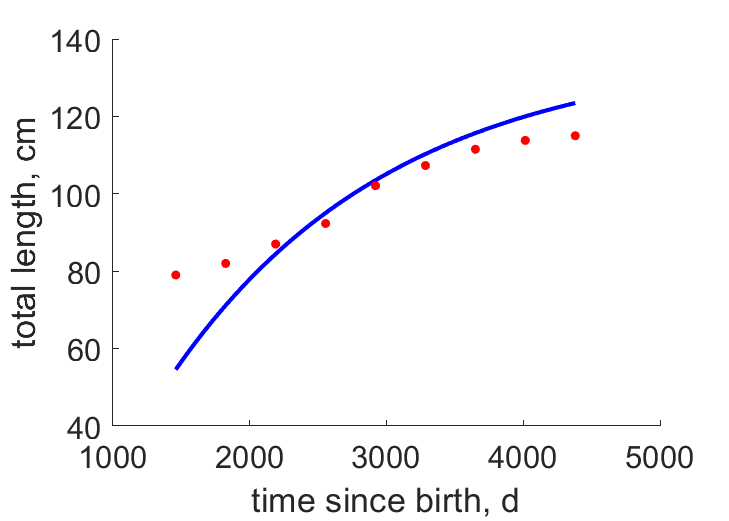Predictions & Data for this entry
| Model: abj | climate: EF | migrate: Mo | phylum: |
| COMPLETE = 2.5 | ecozone: MN | food: bjPz, jiCi | class: |
| MRE = 0.045 | habitat: 0bMcb, bpMp, piMd | gender: D | order: |
| SMSE = 0.007 | embryo: Mnm | reprod: O | family: |
Zero-variate data
| Data | Observed | Predicted | (RE) | Unit | Description | Reference |
|---|---|---|---|---|---|---|
| ab | 300 | 266.7 | (0.1111) | d | age at birth | ShevJoha2011 |
| ap | 2190 | 2260 | (0.03181) | d | age at puberty | WienJoha2011 |
| am | 5840 | 5840 | (2.386e-06) | d | life span | WienJoha2011 |
| Lb | 2 | 2.067 | (0.03365) | cm | total length at birth | MunkNiel2005 |
| Lp | 80 | 77.63 | (0.02958) | cm | total length at puberty | WienJoha2011 |
| Li | 138 | 137.2 | (0.00594) | cm | ultimate total length | WienJoha2011 |
| Wwi | 3.2e+04 | 3.166e+04 | (0.01077) | g | ultimate wet weight | WienJoha2011 |
| Ri | 116.4 | 115.9 | (0.004486) | #/d | maximum reprod rate | WienJoha2011 |
Uni- and bivariate data
| Data | Figure | Independent variable | Dependent variable | (RE) | Reference |
|---|---|---|---|---|---|
| tL |  | time since birth | total length | (0.07172) | Andr1954 |
| tW |  | time since birth | wet weight | (0.154) | Andr1954 |
Pseudo-data at Tref = 20°C
| Data | Generalised animal | Anarhichas denticulatus | Unit | Description |
|---|---|---|---|---|
| v | 0.02 | 0.01713 | cm/d | energy conductance |
| p_M | 18 | 230.3 | J/d.cm^3 | vol-spec som maint |
| k_J | 0.002 | 0.002 | 1/d | maturity maint rate coefficient |
| k | 0.3 | 0.04538 | - | maintenance ratio |
| kap | 0.8 | 0.733 | - | allocation fraction to soma |
| kap_G | 0.8 | 0.8008 | - | growth efficiency |
| kap_R | 0.95 | 0.95 | - | reproduction efficiency |
Facts
- Found in the North Atlantic and Arctic (Norwegian and Barents sea) (Ref: WienJoha2011)
- Tolerates temperatures from -1.4 to 7 deg C (Ref: WienJoha2011)
- Fastest growing of the three wolf fishes in the Barents sea, feeds on soft shelled bottom invertebrates, ctenophors, jellyfish and fish. (Ref: WienJoha2011)
- sheds teech in Feb-March because it sheds its teath (Ref: WienJoha2011)
- Spawns april to october but peak spawning is in summer at depths below 400m (Ref: WienJoha2011)
Acknowledgment
- The creation of this entry was support by the Norwegian Science Council (NFR 255295)
Bibliography